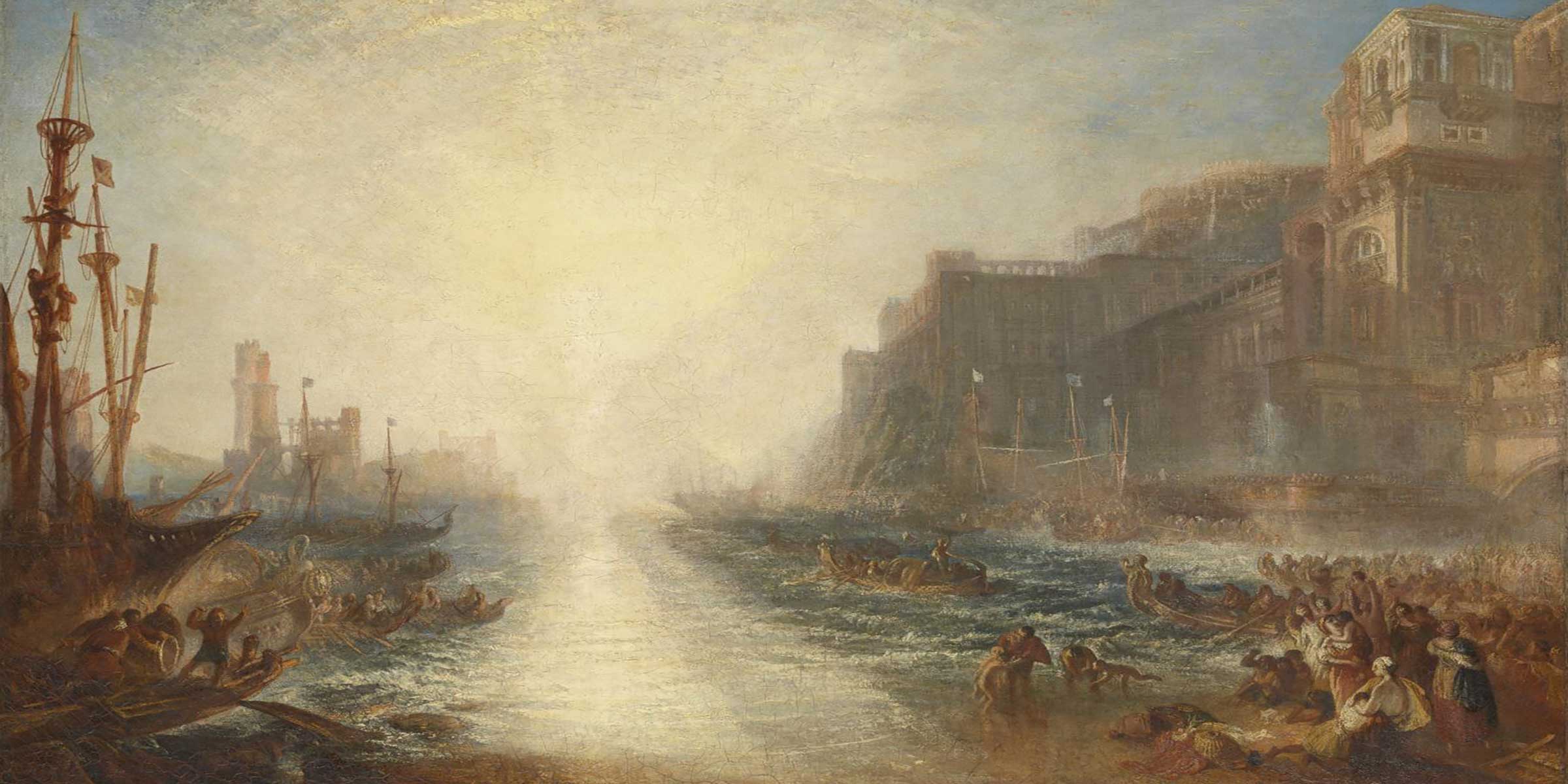Audio brought to you by Curio, a Lapham’s Quarterly partner
History does not reach us only in classrooms and via textbooks; movies, novels, songs, and even video games have shaped how we understand what came before the present for generations. Lapham’s Quarterly is exploring the history and allure of pop culture’s period pieces, artifacts that captivated audiences with their conceptions of the past—and the political and cultural contexts that made these historical fictions so compelling.
In March 2021 the American Historical Review included three video games in its review section, a first for the self-proclaimed “journal of record for the historical profession in the United States.” All three games selected for review are installments of the Assassin’s Creed franchise, which takes as its central conceit a centuries-long struggle between two shadowy organizations: the Templars, who seek to control and manipulate humanity for their own ends, and the Assassins, who champion human freedom and creativity and are usually (though not always) cast as morally superior. Throughout the franchise players are tapped by one or both factions to hunt for powerful artifacts called Pieces of Eden, each of which was hidden or lost long ago. Finding these artifacts requires accessing the past by means of a fictional technology called the Animus, which generates lifelike, interactive virtual-reality worlds from ancient DNA samples taken from the remains of long-dead witnesses to the Pieces of Eden’s fates.
Despite the fantastic silliness of the in-game time-travel logistics, the promise of historical accuracy has been a major selling point of Assassin’s Creed since the eponymous first installment in 2007; since then Ubisoft, its publisher, reports having sold more than 155 million units of the franchise, which has grown to include a total of twelve main games (the most recent being 2020’s Assassin’s Creed: Valhalla, which takes place mostly in Viking-age England). “Assassin’s Creed is steeped in historical fact,” a video-game reviewer for IGN writes of the first game in the series, which is set primarily in the twelfth-century Holy Land. “Were it not for the ‘anomalies’ that flitter around characters”—part of the sci-fi wrapping—“you would have little reason to ever question that this is indeed what these cities and people looked like centuries ago.”
In the first of the AHR reviews, historian of early America Michael D. Hattem gives a positive assessment of Assassin’s Creed III (2012), praising the verisimilitude of its Revolutionary War–era colonial American setting as well as the way the game emphasizes social history. “The attention paid by the game developers and their historical consultants to details of both the actual and social geography of these urban settings,” he writes, “produced one of the most authentic depictions of eighteenth-century life in popular culture”—far more historically accurate, he adds, than Lin-Manuel Miranda’s Broadway musical Hamilton. Video games like this, Hattem concludes, are “ideally situated as a cultural form to tell the kind of complex story of the Revolution reflected in recent academic scholarship.”
By contrast, Christopher P. Magra, a scholar of American Revolution–era maritime history, expresses serious reservations about Assassin’s Creed: Black Flag (2013), which is set in the Caribbean during the early eighteenth century. “There is a degree of historical authenticity baked into these people and places,” especially in the forthrightness about Caribbean slavery, he concedes, but ultimately “the game isn’t very historically accurate” because it condenses geography and modernizes language. Further, he complains, the game’s lead writer, who in an interview with gaming website Polygon attributed much of the game’s sensibilities to well-respected mass-market books like Matthew Parker’s The Sugar Barons (2011), “does not seem to have read academic histories of piracy. Nor does he appear to have examined primary sources in archives.” Magra’s final verdict is that the game is not merely inaccurate but also borders on immoral: “If a video game or movie or novel is going to base sales on historical content, then there exists an ethical obligation to deliver more than entertainment.”
Finally, Julien Bazile, an advanced PhD candidate writing a dissertation on piracy and slavery in the Assassin’s Creed games, offers a mixed review of how Assassin’s Creed: Freedom Cry (2013, originally released as an expansion to Black Flag and set in colonial Haiti) represents the early modern Caribbean world, and in particular the cause and effect of Caribbean slave rebellions. He directs his most forceful criticism not at the game itself, however, but at his fellow historians, citing a systemic “lack of literacy when it comes to analyzing the representation of the past in video games from a historical point of view.” What do historians mean when they call a work of art “realistic” or not? “Stylistic realism does not always imply accuracy,” Bazile reminds us, and “when accuracies are to be found, they are best explained considering the function they play within the game.”
By selecting three different reviewers, only one of whom has experience researching historical representation in video games, the AHR opted out of defining a coherent theory or methodology for assessing representations of history in video games. For a publication written by and for historians, this makes a degree of sense; presumably norms will emerge through discourse over time as more historians agree to review this sort of media. For now, though, trying to discern from these three reviews whether the Assassin’s Creed franchise is historically accurate is something of an exercise in frustration. If not even experts can agree whether the games are “accurate” or “authentic,” perhaps there is another metric by which we might evaluate the games’ success or failure.
The most tantalizing loose end for me, a casual player of the games and a holder of a PhD in history, is the brief editorial note that introduces the section, which justifies the AHR’s decision to branch into video-game reviewing as coming out of concern for what nonhistorians derive from playing historically themed video games. “For good or for ill,” it explains, “many young people receive their initial impressions of historical epochs, characters, and events in this visually compelling ludic format, and historians should pay attention to these virtual renderings of the past.”
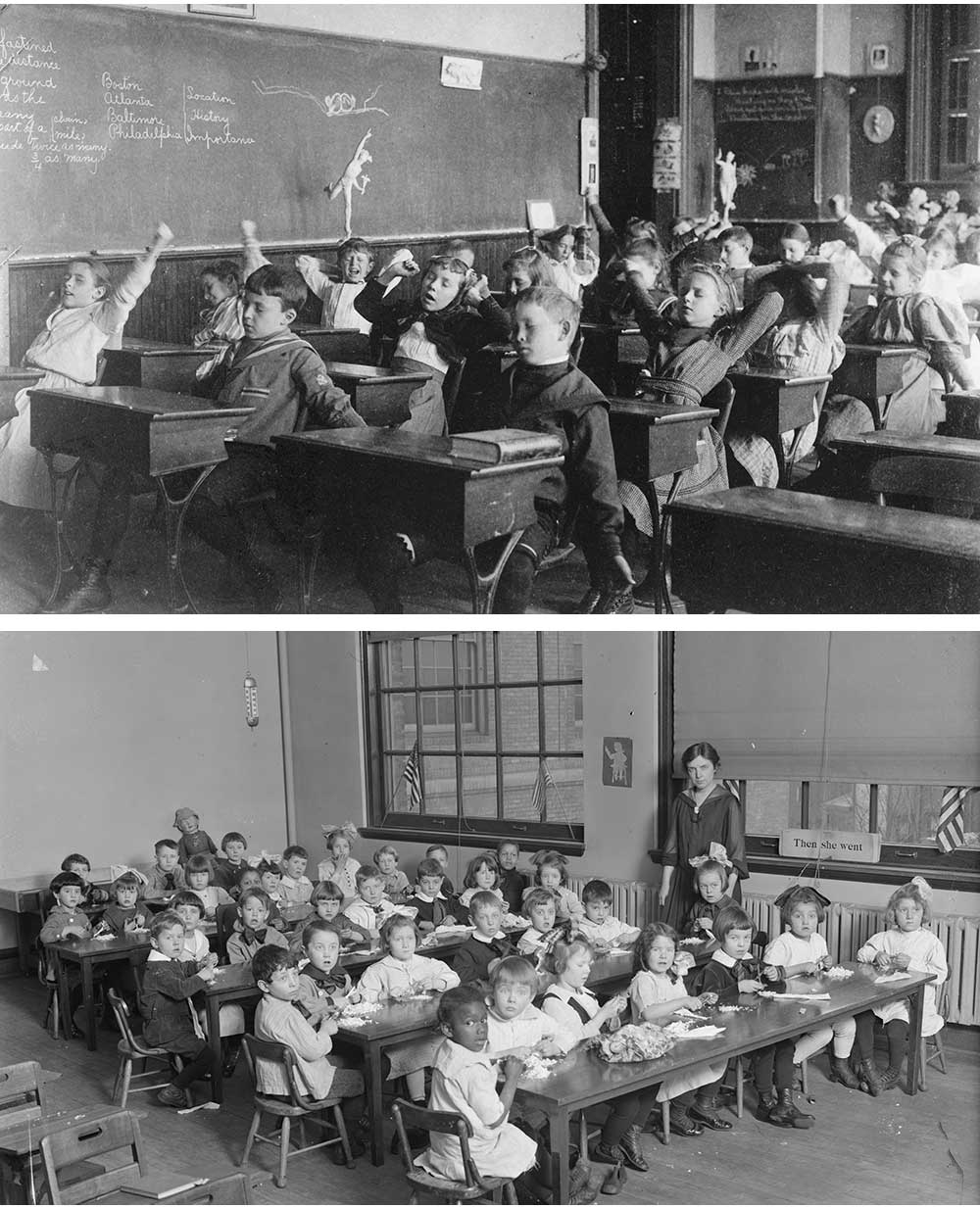
Does Assassin’s Creed actually have an impact on how young people understand history? One illuminating attempt to answer this question appeared in the journal Theory and Research in Social Education in 2019. Lisa Gilbert, a lecturer at Washington University in St. Louis, conducted qualitative interviews in which she asked fourteen teenage boys who had played at least one Assassin’s Creed game to explain how, if at all, the series had influenced their understanding of history.
Most of the boys Gilbert interviewed reported having a low or moderate preexisting interest in history. Many said that they didn’t think the game had measurably influenced their social studies grades or even taught them historical information, which they largely equated with the rote memorization of dates and names. They also seemed to understand quite well that AC is a work of fiction, not fact. Gilbert describes one hesitating when asked to categorize ACIII characters as “historical” or “fictional”—the game’s George Washington, he made sure she knew he understood, was both at once.
What the boys did nearly unanimously report to Gilbert is that Assassin’s Creed had made them feel more emotionally connected to the past. “It’s not like you’re learning about history” from playing the games, one explained. “You’re experiencing it.” As another put it, “Assassin’s Creed reminds us that history is more than just words on a page. History is human experience.” An interviewee named Henry told Gilbert about the powerful emotional reaction he experienced after playing through ACIII’s portrayal of the Boston Massacre and realizing, for the first time, how frightened participants in the actual event would have been: “That was a terror not like anything I had ever read. But I felt that.”
The primary purpose of Assassin’s Creed is to make money for Ubisoft, and the series’ attention to historical detail, as sublime as it can be, must be understood to exist primarily in service of that purpose. But why is historical detail a selling point for action-adventure video games in the first place?
When academics wish to interrogate the purpose of detail in a work of fiction, their first stop is often French literary theorist Roland Barthes’ concept of the reality effect, which he outlined in his essays “The Discourse of History” (1967) and “The Reality Effect” (1968). His subject is the inclusion of mundane, seemingly irrelevant details in narrative works, such as the wall-hung barometer that is mentioned in one of Gustave Flaubert’s short stories despite having no bearing on the plot. “What is the significance,” he asks, “of this insignificance?” The answer, Barthes posits, is that detail serves to make a narrative feel real.
Barthes further asserts that the “unavowed verisimilitude which forms the aesthetic of all the standard works of modernity” is itself a by-product of the pervasive modern misconception that history is equivalent to the reality of the past. The idea of an objective historian is pure illusion, he writes, because history “does not follow the real, it merely signifies it, constantly repeating this happened.” In modern literature and modern history alike, Barthes concludes, the purpose of details is to “say nothing but this: we are the real.”
In his 2001 book The Shock of the Real, Gillen D’Arcy Wood builds on Barthes’ concept of the reality effect to explain the emergence of immersive visual art, much of it inspired by history, as a form of middlebrow entertainment in early nineteenth-century England. One of his examples is an 1821 London exhibition in which recently excavated artifacts from Egypt’s Valley of the Kings—sent to England by the Italian explorer Giovanni Battista Belzoni—were installed in “a veritable dreamscape of mocked-up tombs, statues, and sarcophagi.” Walking through the dimly lit halls of Belzoni’s tomb, Wood argues, would have “belonged to a different order of the imaginary” than reading Flaubert: it offered “an idea of simulated experience” that enraptured the general public but baffled—and sometimes disgusted—elite critics.
One of the most appalled critics of “realistic” immersive entertainment was the essayist Charles Lamb (1775–1834), who in his essay “The Barrenness of the Imaginative Faculty in the Productions of Modern Art” identified an abundance of detail as one of its worst features. The primary target of Lamb’s screed was the painter John Martin (1789–1854) and in particular Martin’s painting Belshazzar’s Feast, a surprise blockbuster when it was exhibited at the British Institution in 1821, the same year Belzoni’s tomb opened its doors.
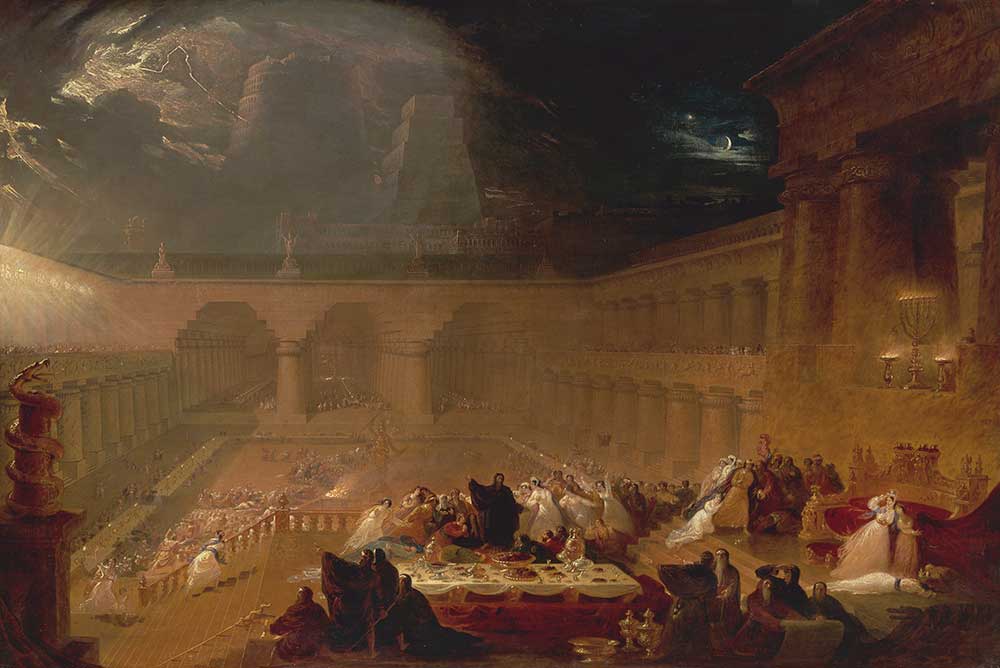
Martin’s subject for the painting is an episode from the Book of Daniel in which a lavish feast held by the Neo-Babylonian prince Belshazzar to celebrate the looting of the First Temple is interrupted by a divine hand writing on the wall. Whereas other artists who painted the scene (notably Rembrandt) opted for tight compositions centering either a regal Belshazzar or the divine hand, Martin went with an epic, immersive scene of terror and destruction. The bulk of the canvas, which measures roughly two and a half by four feet, is taken up not by people but by architecture—the Tower of Babel, a ziggurat, arcaded halls that extend to the edges of the painting—using tricks of perspective and light to produce the effect that the viewer is inside the scene, rather than safely viewing it from outside.
To a modern eye, Martin’s depiction of sixth-century-bc Babylon is not at all historically accurate. The artist did take great pains to represent the ancient city as faithfully as was possible in the early nineteenth century. He adhered closely to the only two proto-archaeological descriptions of the site available to him, Claudius Rich’s 1815 Memoir on the Ruins of Babylon and Thomas Maurice’s 1816 Observations…on the Ruins of Babylon, and filled in the gaps by trying to think historically. “It was the custom of Nebuchadnezzar, the conqueror of Egypt and India, to bring from these parts to Babylon all the architects,” Martin explained in an 1821 pamphlet accompanying the painting. “Therefore I suppose the united talents of the Indian, the Egyptian, and Babylonian architects were employed to produce these buildings.”
This flamboyant use of “historical” detail was, in fact, what most enraged Lamb, who denigrated Martin’s attempt to include “all that was to be seen at any given moment by an indifferent eye” in the work. “Not all that is optically possible to be seen,” Lamb imperiously pronounced, “is to be shown in every picture.” Lamb’s vendetta against detail was snobbish, to be sure, but also had a moral dimension: excessive detail in art is vulgar, in essence, because it erodes the viewer’s capacity for imagination.
For Martin’s defenders, however, the detail was the appeal. “In painting one picture he paints a thousand,” a reviewer for Arnold’s Magazine of the Fine Arts wrote of Martin in 1833. “Every column, every temple, and every vase of gold is a separate study in itself.” Likewise, a reviewer for The Edinburgh Review asserted that for Martin to have omitted any of the details of Belshazzar’s Feast “would have been to tell that portion of his story more imperfectly. The artist has to represent not some individual action, but a scene in which numberless actions are working to one end…Every thing, in a word, combines to excite and sustain that emotion of sublime and supernatural awe.”
Martin’s great legacy was his skill for using scale and detail to “popularize and make immediate vanished civilizations,” as his biographer William Feaver put it. A key to this popularization was Martin’s committed effort to ensure that his paintings retained their power when translated into commercial prints, which he produced and sold widely enough that they filtered into the popular imagination of the time. The Brontë sisters, for example, grew up with a print of Belshazzar’s Feast hanging on the walls of their father’s Yorkshire parsonage; scholars have pointed out its apparent influence in works like Shirley. In 1828 the poet Bernard Barton found himself so overcome by seeing a print of Martin’s The Deluge that he immortalized the experience in verse, sounding not unlike the teenaged Henry who “felt” history when he played Assassin’s Creed:
The awful vision haunts me still!
In thoughts by day, in dreams by night
So well had art’s creative skill
There shown its fearless might.
Despite his commercial popularity, Martin was never accepted by the gatekeepers of the fine-arts world. By contrast, the Dutch artist Lawrence Alma-Tadema (1836–1912), who was born fifteen years after the first exhibition of Martin’s Belshazzar’s Feast and also built his career on large, lavishly detailed paintings of historical (or semihistorical) scenes from antiquity, was overwhelmingly celebrated by Britain’s elite art world after moving permanently to London in his thirties.
Like Martin, Alma-Tadema was preoccupied with scientific accuracy in his paintings, but the younger artist had at his disposal a far better set of tools for achieving that goal. First, the field of archaeology had advanced dramatically as the nineteenth century progressed, resulting in a far greater number of excavated sites and objects for Alma-Tadema to consult. Second, the increasing professionalization of archaeology meant a better general understanding of archaeological contexts and assemblages—in other words, a vastly improved sense of which objects would be used for which purposes in which locations, by which types of people, and during which historical periods. Alma-Tadema also had the benefit of increasingly accessible photography, which allowed him to reproduce buildings and artifacts with great precision; an avid photographer himself, he spent his honeymoon snapping his own reference shots among the ruins of Pompeii.
Where Martin had to take leaps of logic to flesh out the buildings, costumes, and tableware of ancient Babylon and Nineveh—“Here is how the scene might have looked”—Alma-Tadema took full advantage of the scholarly and technological advances of the mature nineteenth century to produce paintings that not only felt but also looked real, even to experts. One notable Alma-Tadema fan (and personal friend) was the German writer Georg Ebers, a founding father of modern Egyptology. Ebers was especially enraptured by the artist’s depiction of Ramses II in his 1872 Death of the Pharaoh’s Firstborn Son. “To the Egyptologist,” he wrote of the painting, “it tells much that the untutored eye does not perceive. This is a resurrection of real Egyptian life! There is nothing which did not belong to the days of the pharaohs.”
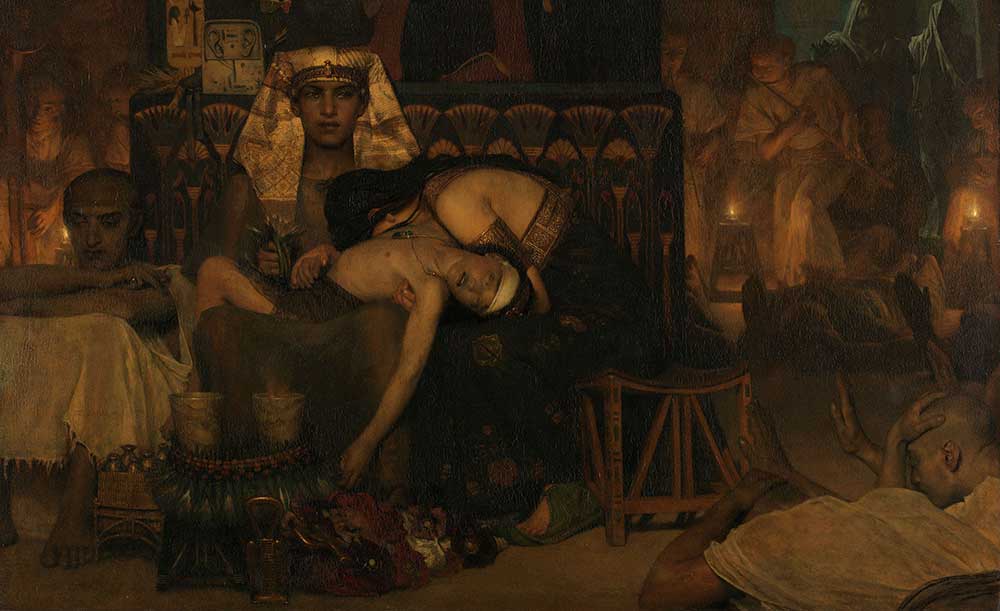
While Alma-Tadema’s details may have been far more accurate than Martin’s, his real power lay in his skill for using those details to provoke in viewers a sublime, timeless feeling of humanity. As a critic wrote in 1880 for the Pall Mall Gazette, his paintings “represent the realistic portrayal of a society long since passed away, which he has made to live again for us by dint of the combination of exceptional executive power with exceptional archaeological study. In this respect, his pictures have been a kind of historic revelation to many people not of any great events but of the social aspect and artistic characteristics of a past epoch.”
That is not to say that Alma-Tadema received no negative critiques. “What human interest,” Contemporary Review critic John Forbes wrote of Alma-Tadema’s contributions to the Royal Academy Exhibition of 1873, “can we, living in the nineteenth century, have in painting, or having painted for us, those half-naked sensuous Greeks, lying on couches and drinking their wine out of flat paterae?” Twelve years later, the critic Claude Phillips lodged a similar complaint regarding Alma-Tadema’s 1885 A Reading from Homer, this time based on borderline phrenological grounds. “The facial types, though they have an air of realistic truth, are of a low order, and not such as should have been selected for such a subject,” Phillips wrote. “Not so, surely, looked the Greeks!” Alma-Tadema painted from life, so Phillips is technically correct—but the characterization of the figures’ faces as “haggard” and “unintelligent” would likely have rankled the models, who were often Alma-Tadema’s friends, family members, and patrons.
In an 1883 lecture, John Ruskin laid bare the political subtext and anxieties behind many contemporary negative reactions to Alma-Tadema. Despite the artist’s great technical skill, Ruskin argued, the way he shows the past borders on subversive: “Alma-Tadema does but represent—or rather, has haplessly got himself entangled in—the vast vortex of recent Italian and French revolutionary rage against all that resists, or ever did resist, its license; in a word, against all priesthood and knighthood.” Paintings of classical antiquity, he asserted, ought to glorify beautiful and noble subjects like the might of Achilles. Instead, Alma-Tadema “seems to hold it his heavenly mission to portray” ancient people in a “bacchanalian frenzy,” by which Ruskin seems to have meant simply going about their daily lives in a way that nonelite viewers of the day found engaging. As Feaver put it in his biography of Martin, “historical reconstruction is a way to challenge time.” In Ruskin’s critiques of Alma-Tadema’s paintings, we see that it can also be a subtle way to challenge history, meaning the stories we are told about the past—as well as a way to signal to nonelite demographics that history belongs to them, too.
The Animus, the fictional technology that underpins the Assassin’s Creed franchise, doesn’t permit the user to change the past or physically travel there, but only to experience it more vividly. In other words, the series correctly identifies technology as a powerful factor in how we (historians and laypeople alike) access and connect with the past, and it illustrates how major leaps in technological progress have the potential to open up radical new ways of seeing and learning from the bygone world.
The device of the Animus also serves as a buffer between the actual past and the version of it presented on-screen, providing Ubisoft with some cover for inaccuracies in historical detail—as well as the opportunity for some self-referential humor. In its reconstruction of early eighteenth-century Havana, Assassin’s Creed: Black Flag contains a notable anachronism in the form of the Catedral de la Virgen María de la Concepción Inmaculada, which was not actually completed until 1748, a couple of decades after the game’s setting. Players who poke around the in-game Codex, a database of information about the historical (and semihistorical) places and people included in the game, might notice that the developers included a joke acknowledging the discrepancy in the form of a set of memos between several employees of Abstergo, the sinister corporation that developed the Animus and, in this installment, has begun experimenting with marketing the technology as entertainment.
Note: As much as I love this building—truly “music set in stone”—we simply can’t use it. 1748 is far too late for this Virtual Experience. Around 1720 it would be a small, rough church rising from drained swampland. Sorry.—DM
Note: What? We’re selling climbable buildings! We’ll fudge the dates.—ML
Note: I am not on board with fudging dates.—DM
Note: Here at Abstergo Entertainment: Beauty before Truth. Not for us John Keats and his tidy odes. Truth is Beauty? Beauty is Truth? People want to see landmarks.—RL
A more straightforward way Ubisoft has signaled its flexible but earnest historical ethos is with the introduction, in 2018, of a “Discovery Tour” mode that gives players the option to disable all story and combat aspects, removing the veneer of plot and turning the game into a pure simulation. When the mode is activated, players can choose to sightsee at their own pace or participate in any of several packaged “tours” in which a narrator, documentary-style, explains the historical background of some aspect of the virtual world.
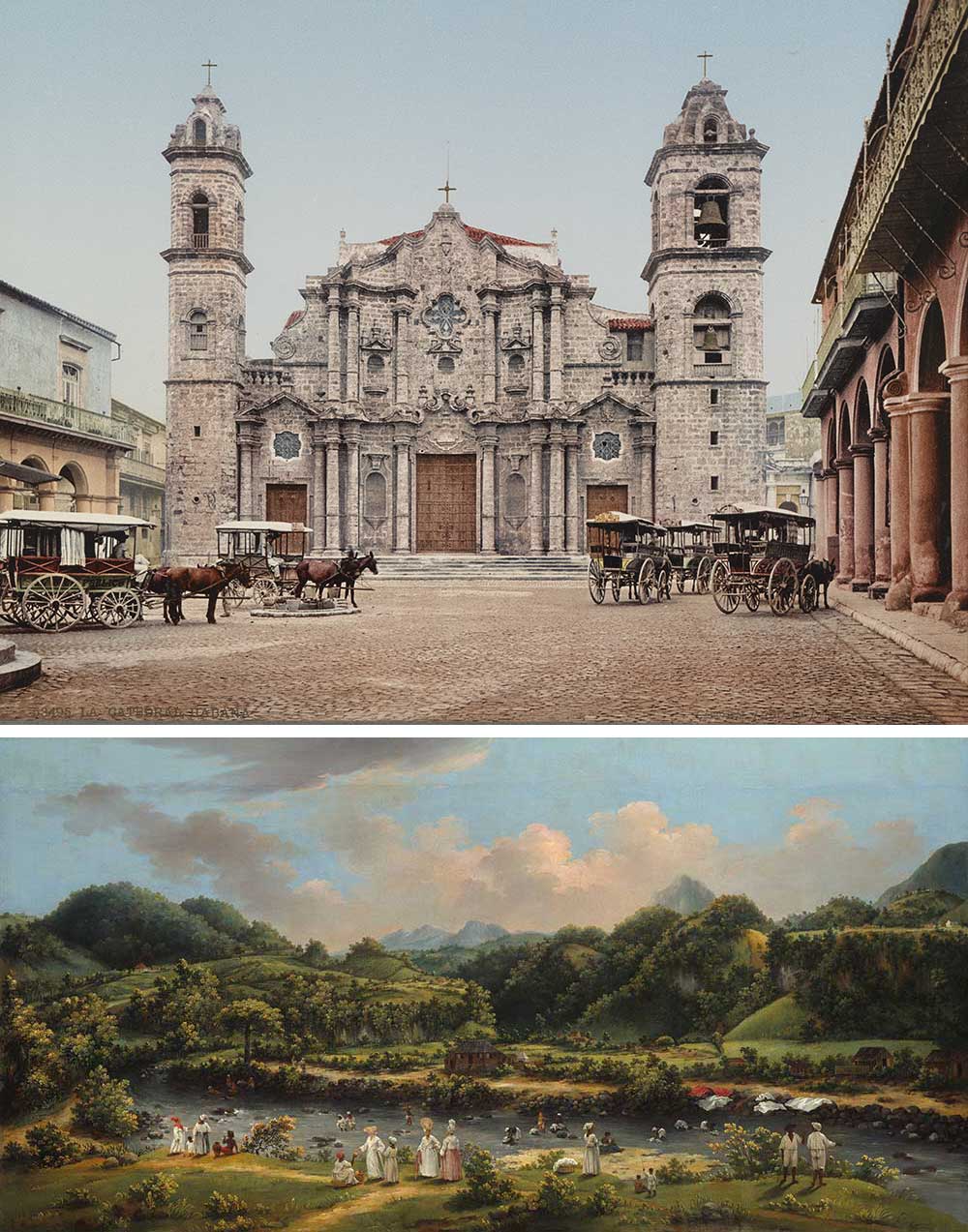
Some of the tours focus on the buildings and monuments that appear in the games, showing how the developers consulted photographs and artists’ reconstructions of actual ruins in order to make their renderings as accurate as possible. Other tours focus on social history—the daily life of women, the work of craftspeople—according to up-to-date interpretations by historians. In a tour titled “Beer and Bread” in AC: Origins, for example, a narrator explains the manufacture and ritual uses of food staples in Ptolemaic Egypt, noting that despite attempts by modern archaeobotanists such as Delwen Samuel to replicate ancient beers, many questions remain about the recipes and ingredients. The player follows an illuminated pathway through a large brewery-bakery complex bustling with nonplayer characters; at one point the narrator explains that in addition to acting out the steps of brewing beer and baking bread the characters have been programmed to occasionally clutch their jaws, signifying a toothache, a nod to the worn-down teeth of ancient Egyptian skeletons, which scholars believe resulted from the impossibility of keeping sand out of dough in open-air bakeries.
According to Maxime Durand, the lead historian on the games, Ubisoft considered adding the Discovery Tour mode for almost a decade before they finally did so. With Origins’ re-creation of first-century-bc Egypt “we had this fantastic setting,” Durand told the Guardian of the decision to release the mode in 2018, but “we also have the legitimacy to do it now, after all these games showing that we treat history with respect.” Ubisoft has primarily marketed the Discovery Tour mode for its educational potential, and it has been embraced by many educators, museum professionals, and even the ivory-tower crowd. Unable to hold its May 2021 fundraising gala in person due to the ongoing pandemic, the august American School of Classical Studies at Athens asked archaeologist John Camp, who has directed excavations at the Athenian Agora since 1994, to virtually guide participants through several Discovery Tour sites in AC: Odyssey’s fifth-century-bc Greece. In the tour, which the ASCSA has made available for the public to stream, Camp points out the sometimes stunning degree of accuracy that appears even in parts of the game players are likely to miss, such as the carefully engineered fish-scale-like roof tiles of the Agora’s circular Tholos building. He also sanguinely acknowledges various liberties taken by the designers, such as the presence of a door on the back wall of the Stoa Poikile—which is not attested by the archaeological evidence, Camp explains, because that part of the building hasn’t yet been excavated. It seems wrong to call the door “inaccurate,” considering that it could be discovered as the Agora excavations progress. Instead it is more of a hypothesis: falsifiable but plausible based on the currently established facts.
Beyond its straightforward informational value the Discovery Tour also seems to hold some ineffable emotional power over players, many of whom describe feeling newly connected to the past after spending time with the feature. After the mode’s release for AC: Odyssey, reviewer Colin Campbell writes in Polygon that “it inspired me to spend time thinking about history and my place in it, as opposed to merely taking on board a little more information about that particular world.” Likewise, members of Reddit’s Assassin’s Creed subforum are—despite their propensity to argue over whether the game’s history is accurate or not—broadly smitten. In 2019 Redditor Whoopy2000 described having his mother over to explore the Discovery Tour mode in AC: Origins: “Damn, it was awesome to see her eyes tearing up a bit from joy and happiness…Her favorite parts were the ones when you find a building you can enter and just observe people doing their things.”
Returning to the regular game mode after completing one of these tours, you might notice that the nonplayable characters are all programmed to follow daily routines based on their social roles. Merchants hawk wares, groups of women weave and fetch water, children play, fishermen fish. At night they go home to sleep, some to dirty hovels and some to neat townhouses, and then in the morning they wake up and do it all over again. They do these things regardless of whether we players pay attention to them—which might, if you’re feeling reflective, make you think about how the regular people of the past lived their lives in full detail regardless of whether they ended up in history books.
Like Martin’s and Alma-Tadema’s history paintings, the Assassin’s Creed games aren’t really about the past. Instead they’re about how the people of the present engage with history, which we should remember is a human field of study that even at its most rigorous has yet to give any individual unfettered access to the reality of the past. They remind us that history—necessarily imperfect and messy, always in the process of being corrected—can be something more sublime than Barthes’ “fake discourse” that does nothing but repeat “this happened” if we only let it.
Read other entries in this series: Kristen Martin on orphan trains, Dylan Byron on E.M. Forster’s Maurice, Jeremy Swist on heavy metal’s fascination with Roman emperors, and Emma Garman on the Happy Valley set.
